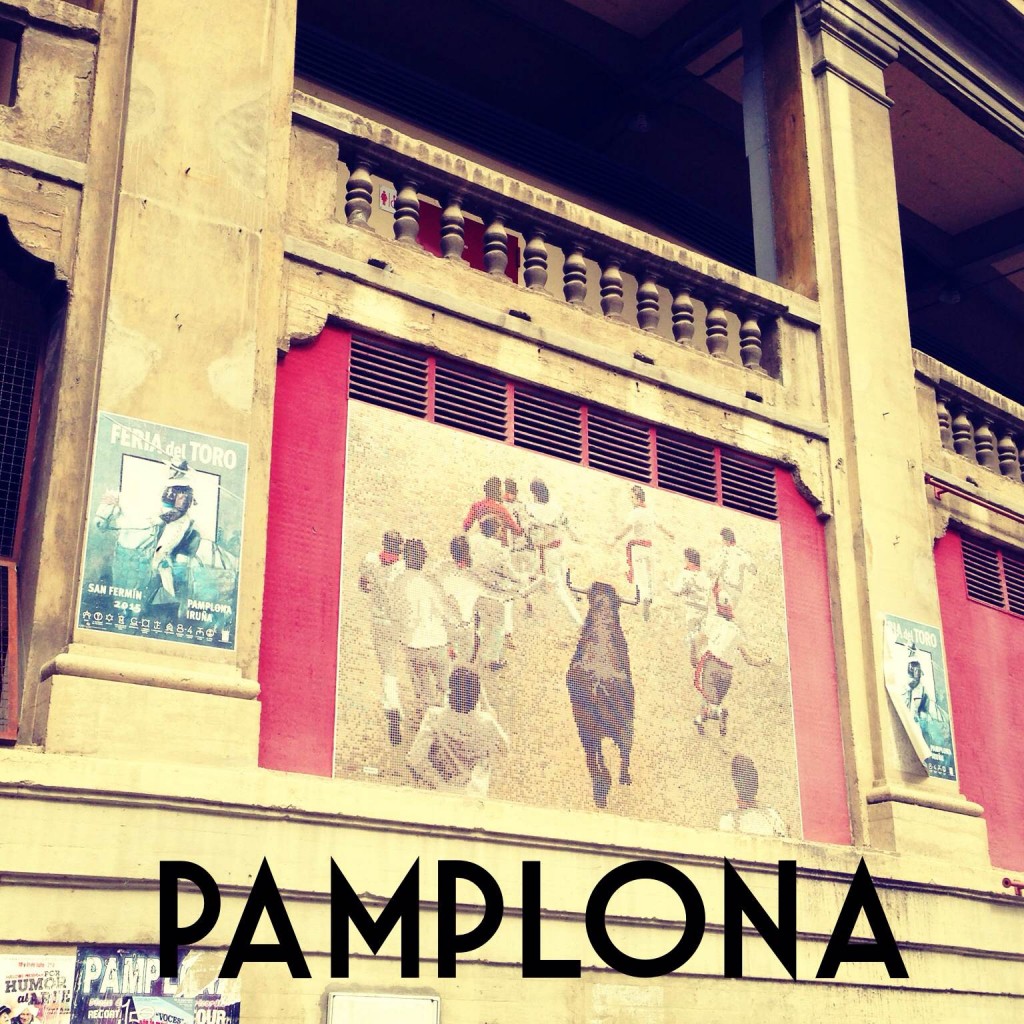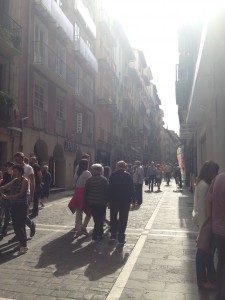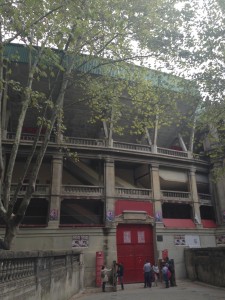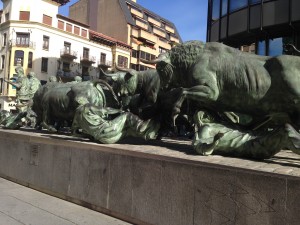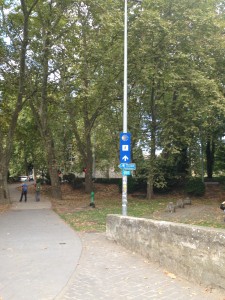This past weekend, I visited Pamplona with a friend. You may not know anything about Pamplona, but don’t worry! I would love to let you in on Pamplona’s famous sites and festivals. This city is most known for its Festival de San Fermin which is also known as The Running of the Bulls. (I bet now you are saying, “Oh, that city!”) This festival happens every year from July 7-July 14 in the small city of Pamplona which is to the northwest of Zaragoza. The Festival de San Fermin is one of Spain’s most known festivals and people from around the world come to see the craziness that is the Running of the Bulls. My friend and I only visited for the day because it is not a very big city, and one day is enough to get the feel of Pamplona and visit its well-known spots. When we first arrived in Pamplona, we started out at the beginning of the route that the bulls run, “ruta de encierro”. This famous tradition started out of pure necessity as it was the way of getting the bulls to the bullfight located in the Plaza de Toros. People from the city would lead the bulls to the bullring starting the tradition. Later, the tradition of having them run through the streets was banned but still happened every year because it was so popular and unique. Since then, the ban has been lifted because it was practically impossible from having this tradition stopped and the festival now brings many visitors to the city each year. The actual route that the bulls take is very short, only 825 meters. There is one point in the route where the bulls have to complete a 90° turn, the Curva de Estafeta, which is quite dangerous. The end of the route is the Plaza de Toros which is a huge bullring. We were not able to get inside, but judging from the outside, it is huge and historic. If I were ever to go to the Festival of San Fermin, I would try to watch from a balcony overlooking the route. I think that would be the only way to actually see everything safe and sound!
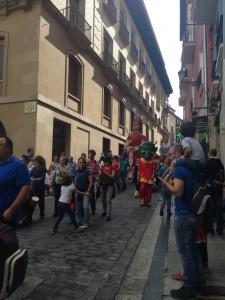 We were very surprised
We were very surprised  to encounter a festival while we were in Pamplona. After some research, I found out that it was called the Fiestas de San Fermin Txikito which took place Friday through Sunday. This festival included music, concerts, activities, and much more. We walked into (quite literally) the festival in the morning when there was a parade of the “gigantes y cabezudos”. “Gigantes y cabezudos”, popular in Spanish festivals and parades, are giants and big heads that are worn during festivals. They usually wear traditional clothing and commemorate historical and acclaimed people. It was interesting to see this and hear everyone singing while a parade of sorts was going on. We picked a good day to visit Pamplona!
to encounter a festival while we were in Pamplona. After some research, I found out that it was called the Fiestas de San Fermin Txikito which took place Friday through Sunday. This festival included music, concerts, activities, and much more. We walked into (quite literally) the festival in the morning when there was a parade of the “gigantes y cabezudos”. “Gigantes y cabezudos”, popular in Spanish festivals and parades, are giants and big heads that are worn during festivals. They usually wear traditional clothing and commemorate historical and acclaimed people. It was interesting to see this and hear everyone singing while a parade of sorts was going on. We picked a good day to visit Pamplona!
The Camino de Santiago goes through Pamplona and the city has many hostels and hiking stores to accommodate those who walk the Camino. The Camino de Santiago (St. James Path) is the name given to the multiple routes to the Cathedral of Santiago de Compostela in Galicia, Spain. People that walk the route are called “peregrinos” or pilgrims and can choose how long they walk which usually varies from a week to a few months. Many people walk the Camino for spiritual growth and understanding. People have been walking to the shrine of St. James for centuries, and now, people from around the world take part in walking this route. Some routes of the Camino also lead people through Zaragoza next to the famous Basilica del Pilar. While in Pamplona, we walked part of the Camino which is always very well marked. The shell is the symbol of the Camino because shells are commonly found in Galicia, where the Cathedral of Santiago de Compostela is located. Peregrinos often find shell markers on the sidewalks that lead them along their walk.
We also spent some time at The Cathedral of Santa Maria which is very gorgeous. We loved looking at all the beautiful chapels and alters. There is also a museum included in this cathedral called the Museo Diocesano. This was also petty interesting as it included a variety of religious relics.
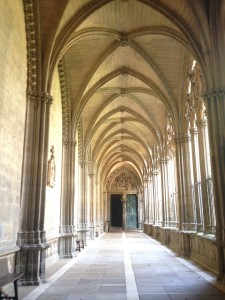
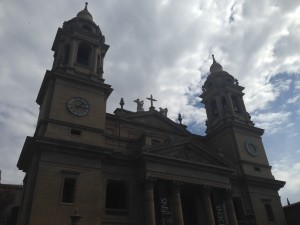
La Ciudadela, another famous site in Pamplona, is an enormous park that is almost as big as the city center itself. It was constructed for military uses centuries ago, but now is a huge grassy area. The unique thing about this park is that it not just flat, but is constructed from many layers. It’s actually quite difficult to describe, and therefore I will let the pictures do most of the writing. This place was quite fun to walk around it. Oftentimes we could not figure out how to get to another level of the park. La Ciudadela is also a great place to rest and catch some sun in the middle of a day of walking.
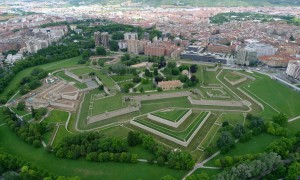
I obviously did not take this, but it shows a great view of La Ciudadela. http://www.aireg.es/la-ciudadela-de-pamplona/
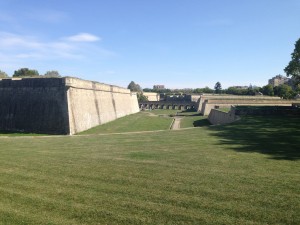
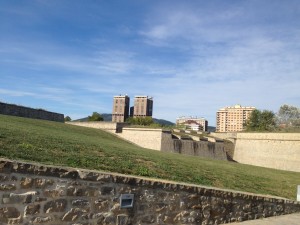
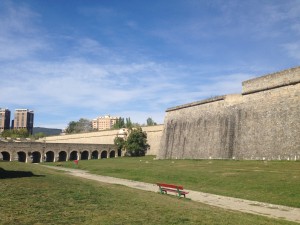

I did not expect to learn as much as I did in Pamplona! I you are ever in Spain, I suggest spending a day or two in Pamplona to walk the route the bulls run and explore this charming city!
__________________________________________________________________________________________________________________________________
Side Note: If you follow world news, you probably heard about the Catalonia voting which occurred on Sunday (9/27). Catalonia is an autonomous community of Spain that is home to Barcelona. Catalonia has been trying to become an independent nation and this voting for seats might propel this into action. My professor said basically that the Catalonian party for separation (Junts per Si) won seats in the parliament, but it is still a long process if they are able to get independence. I have found two articles about this topic here and here. I am by no means qualified to inform others about Spanish politics and I think these will help you understand this subject if it interests you.
